Year 2014 and before
Transport of Intensity phase imaging in the presence of curl effects induced by strongly absorbing photomasks
A. Shanker, Lei Tian, M. Sczyrba, B. Connolly, A. Neureuther, L. Waller
Applied Optics, 53(34), J1 (2014).
We report theoretical and experimental results for imaging of electromagnetic phase edge effects in lithography photomasks. Our method starts from the transport of intensity equation (TIE), which solves for phase from through-focus intensity images. Traditional TIE algorithms make an implicit assumption that the underlying in-plane power flow is curl-free. Motivated by our current study, we describe a practical situation in which this assumption breaks down. Strong absorption gradients in mask features interact with phase edges to contribute a curl to the in-plane Poynting vector, causing severe artifacts in the phase recovered. We derive how curl effects are coupled into intensity measurements and propose an iterative algorithm that not only corrects the artifacts, but also recovers missing curl components.
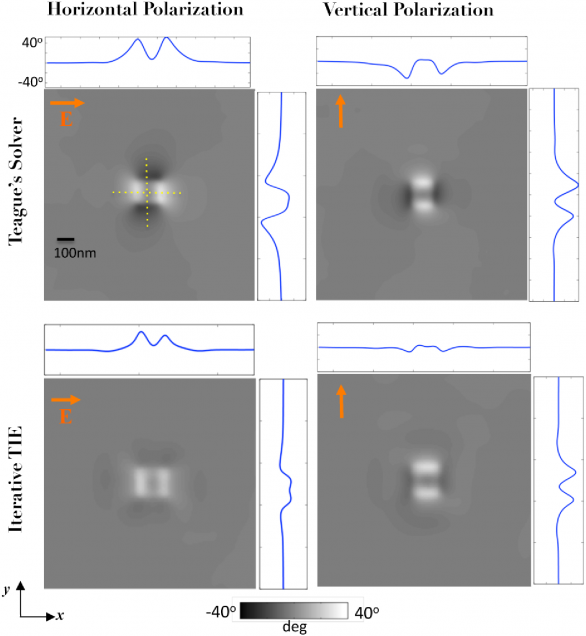
Low-noise phase imaging by hybrid uniform and structured illumination Transport of Intensity Equation
Y. Zhu, A. Shanker, Lei Tian, L. Waller, G. Barbastathis
Optics Express, 22(22) 26696, (2014).
We demonstrate a new approach to the transport of intensity equation (TIE) phase retrieval method which uses structured illumination to improve low-frequency noise performance. In the hybrid scheme, two phase images are acquired: one with uniform and one with sinusoidal grating illumination intensity. The former preserves the high spatial frequency features of the phase best, whereas the latter dramatically increase the response at low spatial frequencies (where traditional TIE notoriously suffers). We then theoretically prove the design of a spectral filter that optimally combines the two phase results while suppressing noise. The combination of uniformly and structured illuminated TIE (hybrid TIE) phase imaging is experimentally demonstrated optically with a calibrated pure phase object.
Transport of Intensity phase imaging by intensity spectrum fitting of exponentially spaced defocus planes
J. Zhong, R. Claus, J. Dauwels, Lei Tian, L. Waller
Optics Express 22, 10661-10674 (2014).
We propose an alternative method for solving the Transport of Intensity equation (TIE) from a stack of through–focus intensity images taken by a microscope or lensless imager. Our method enables quantitative phase and amplitude imaging with improved accuracy and reduced data capture, while also being computationally efficient and robust to noise. We use prior knowledge of how intensity varies with propagation in the spatial frequency domain in order to constrain a fitting algorithm [Gaussian process (GP) regression] for estimating the axial intensity derivative. Solving the problem in the frequency domain inspires an efficient measurement scheme which captures images at exponentially spaced focal steps, significantly reducing the number of images required. Low–frequency artifacts that plague traditional TIE methods can be suppressed without an excessive number of captured images. We validate our technique experimentally by recovering the phase of human cheek cells in a brightfield microscope.
Hamiltonian and phase-space representation of spatial solitons
H. Gao, Lei Tian, G. Barbastathis
Optics Communications 318, 199-204 (2014).
We use Hamiltonian ray tracing and phase-space representation to describe the propagation of a single spatial soliton and soliton collisions in a Kerr nonlinear medium. Hamiltonian ray tracing is applied using the iterative nonlinear beam propagation method, which allows taking both wave effects and Kerr nonlinearity into consideration. Energy evolution within a single spatial soliton and the exchange of energy when two solitons collide are interpreted intuitively by ray trajectories and geometrical shearing of the Wigner distribution functions.
Compressive holographic two-dimensional localization with 1/302 subpixel accuracy
Y. Liu, Lei Tian, C. Hsieh, G. Barbastathis
Optics Express 22, 9774-9782 (2014).
We propose the use of compressive holography for two–dimensional (2D) subpixel motion localization. Our approach is based on computational implementation of edge–extraction using a Fourier–plane spiral phase mask, followed by compressive reconstruction of the edge of the object. Using this technique and relatively low–cost computer and piezo motion stage to establish ground truth for the motion, we demonstrated localization within 1/30th of a camera pixel in each linear dimension.
![]()
Compressive X-ray phase tomography based on the transport of intensity equation
Lei Tian, J. C. Petruccelli, Q. Miao, H. Kudrolli, V. Nagarkar, G. Barbastathis
Optics Letters 38, 3418-3421 (2013).
We develop and implement a compressive reconstruction method for tomographic recovery of refractive index distribution for weakly attenuating objects in a microfocus x-ray system. This is achieved through the development of a discretized operator modeling both the transport of intensity equation and the x-ray transform that is suitable for iterative reconstruction techniques.
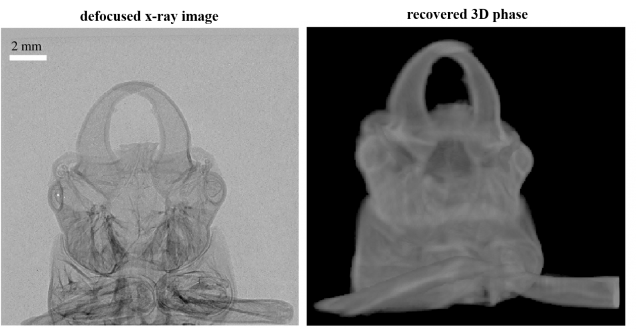
The transport of intensity equation for optical path length recovery using partially coherent illumination
J. C. Petruccelli, Lei Tian, G. Barbastathis
Optics Express 21, 14430-14441 (2013).
*Highlighted in the OSA Spotlight on Optics
We investigate the measurement of a thin sample’s optical thickness using the transport of intensity equation (TIE) and demonstrate a version of the TIE, valid for partially coherent illumination, that allows the measurement of a sample’s optical path length by the removal of illumination effects.
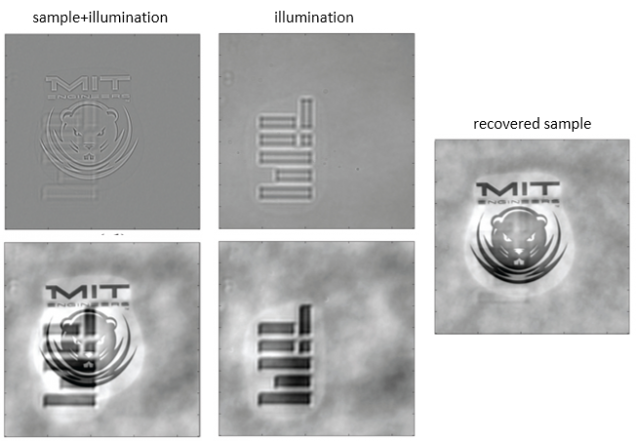
Wigner function measurement using a lens let array
Lei Tian, Z. Zhang, Jon. C. Petruccelli, G. Barbastathis
Optics Express 21, 10511-10525 (2013).
Geometrical–optical arguments have traditionally been used to explain how a lenslet array measures the distribution of light jointly over space and spatial frequency. Here, we rigorously derive the connection between the intensity measured by a lenslet array and wave–optical representations of such light distributions for partially coherent optical beams by using the Wigner distribution function (WDF). It is shown that the action of the lenslet array is to sample a smoothed version of the beam’s WDF (SWDF). We consider the effect of lenslet geometry and coherence properties of the beam on this measurement, and we derive an expression for cross–talk between lenslets that corrupts the measurement. Conditions for a high fidelity measurement of the SWDF and the discrepancies between the measured SWDF and the WDF are investigated for a Schell–model beam.

Nonlinear diffusion regularization for transport of intensity phase imaging
Lei Tian, J. C. Petruccelli, G. Barbastathis
Optics Letters 37, 4131-4133 (2012).
We demonstrate a nonlinear diffusion (NLD) regularization method to solve the transport of intensity equation (TIE). A novel NLD regularization function is proposed to enforce piecewise-constant priors and to remove low-frequency artifacts in the TIE solution.
Wigner functions for evanescent waves
J. C. Petruccelli, Lei Tian, S. B. Oh, G. Barbastathis
Journal of the Optical Society of America A 29, 1927-1938 (2012).
We propose phase space distributions, based on an extension of the Wigner distribution function, to describe fields of any state of coherence that contain evanescent components emitted into a half-space. The evanescent components of the field are described in an optical phase space of spatial position and complex-valued angle. Behavior of these distributions upon propagation is also considered, where the rapid decay of the evanescent components is associated with the exponential decay of the associated phase space distributions. To demonstrate the structure and behavior of these distributions, we consider the fields generated from total internal reflection of a Gaussian Schell-model beam at a planar interface.
Scanning-free compressive holography for object localization with subpixel accuracy
Y. Liu, Lei Tian, J. W. Lee, H. Y. H. Huang, M. S. Triantafyllou, G. Barbastathis
Optics Letters 37, 3357-3359 (2012).
We propose quantitative localization measurement of a known object with subpixel accuracy using compressive holography. We analyze the theoretical optimal solution in the compressive sampling framework and experimentally demonstrate localization accuracy of 1/45 pixel, in good agreement with the analysis.
![]()
Path-independent phase unwrapping using phase gradient and total-variation (TV) denoising
H. Huang, Lei Tian, Z. Zhang, Y. Liu, Z. Chen, G. Barbastathis
Opt. Express 20, 14075 (2012).
Phase unwrapping is a challenging task for interferometry based techniques in the presence of noise. The majority of existing phase unwrapping techniques are path-following methods, which explicitly or implicitly define an intelligent path and integrate phase difference along the path to mitigate the effect of erroneous pixels. In this paper, a path-independent unwrapping method is proposed where the unwrapped phase gradient is determined from the wrapped phase and subsequently denoised by a TV minimization based method. Unlike the wrapped phase map where 2πphase jumps are present, the gradient of the unwrapped phase map is smooth and slowly-varying at noise-free areas. On the other hand, the noise is greatly amplified by the differentiation process, which makes it easier to separate from the smooth phase gradient. Thus an approximate unwrapped phase can be obtained by integrating the denoised phase gradient. The final unwrapped phase map is subsequently determined by adding the first few modes of the unwrapped phase. The proposed method is most suitable for unwrapping phase maps without abrupt phase changes. Its capability has been demonstrated both numerically and by experimental data from shearography and electronic speckle pattern interferometry (ESPI).
Experimental compressive phase space tomography
Lei Tian, J. Lee, S. B. Oh, G. Barbastathis
Optics Express 20, 8296-8308 (2012).
*Highlighted in the OSA Spotlight on Optics
Phase space tomography estimates correlation functions entirely from snapshots in the evolution of the wave function along a time or space variable. In contrast, traditional interferometric methods require measurement of multiple two-point correlations. However, as in every tomographic formulation, undersampling poses a severe limitation. Here we present the first, to our knowledge, experimental demonstration of compressive reconstruction of the classical optical correlation function, i.e. the mutual intensity function. Our compressive algorithm makes explicit use of the physically justifiable assumption of a low-entropy source (or state.) Since the source was directly accessible in our classical experiment, we were able to compare the compressive estimate of the mutual intensity to an independent ground-truth estimate from the van Cittert-Zernike theorem and verify substantial quantitative improvements in the reconstruction.
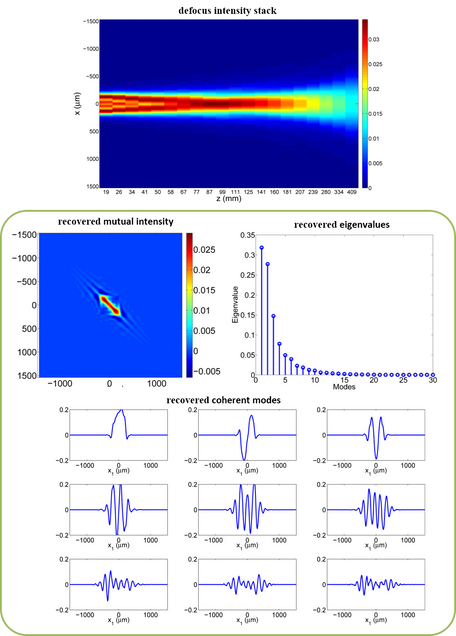
Wigner functions defined with Laplace transform kernels
S. B. Oh, J. C. Petruccelli, L. Tian, G. Barbastathis
Optics Express 19, 21938-21944 (2011).
We propose a new Wigner–type phase–space function using Laplace transform kernels—Laplace kernel Wigner function. Whereas momentum variables are real in the traditional Wigner function, the Laplace kernel Wigner function may have complex momentum variables. Due to the property of the Laplace transform, a broader range of signals can be represented in complex phase–space. We show that the Laplace kernel Wigner function exhibits similar properties in the marginals as the traditional Wigner function. As an example, we use the Laplace kernel Wigner function to analyze evanescent waves supported by surface plasmon polariton.
From Two-Dimensional Colloidal Self-Assembly to Three-Dimensional Nanolithography
C.-H. Chang, L. Tian, W. R. Hesse, H. Gao, H. J. Choi, J.-G. Kim, M. Siddiqui, G. Barbastathis
Nano Letters 11, 2533-2537 (2011).
A number of “top-down” lithographic and “bottom-up” self-assembly methods have been developed to fabricate three-dimensional (3D) nanostructures to support the recent advances in nanotechnology. But they are limited by a number of factors such as fabrication cost, pattern resolution, and/or flexibility of geometry. Here we present a 3D nanolithography process that utilizes self-assembled nanospheres to create a periodic array of focal spots, which are then replicated across multiple depth in a transparent medium according to the Talbot effect. The Talbot field then exposes a pattern onto the underlying photoresist, recording the 3D intensity distribution. We have demonstrated designable complex 3D periodic structures with 80 nm minimum feature size, roughly one-fourth of the operating wavelength. This approach combines 2D colloidal self-assembly and 3D phase lithography, is robust, cost-effective, and widely applicable to nanoscale research and manufacturing.
Aperiodic sub wavelength Lüneburg lens with nonlinear Kerr effect compensation
H. Gao, S. Takahashi, L. Tian, G. Barbastathis
Optics Express 19, 2257-2265 (2011).
We introduce a Lüneburg lens design where Kerr nonlinearity is used to compensate for the focal point shift caused by diffraction of a Gaussian source. A computationally efficient iterative method introduced in [Opt. Lett. 35, 4148 (2010)] is used to provide ray diagrams in the nonlinear case and verify the focal shift compensation. We study the joint dependence of focal shift on waist size and intensity of Gaussian source, and show how to compensate spherical aberration caused by the nonlinearity by a small perturbation of the Lüneburg profile. Our results are specific to Lüneburg lens but our approach is applicable to more general cases of nonlinear nonperiodic metamaterials.
Quantitative measurement of size and three-dimensional position of fast moving bubbles in air-water mixture flows using digital holography
Lei Tian, N. Loomis, J. Dominguez-Caballero, G. Barbastathis
Applied Optics 49, 1549 (2010).
We present a digital in-line holographic imaging system for measuring the size and three-dimensional position of fast-moving bubbles in air–water mixture flows. The captured holograms are numerically processed by performing a two-dimensional projection followed by local depth estimation to quickly and efficiently obtain the size and position information of multiple bubbles simultaneously. Statistical analysis on measured bubble size distributions shows that they follow lognormal or gamma distributions.
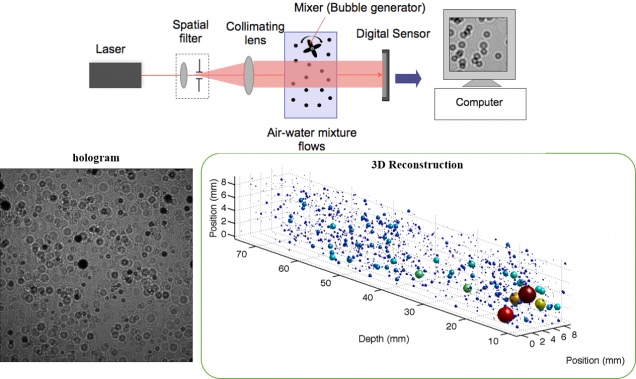
Transport of Intensity phase-amplitude imaging with higher order intensity derivatives
L. Waller, Lei Tian, G. Barbastathis
Optics Express 18, 12552-12561 (2010).
We demonstrate a method for improving the accuracy of phase retrieval based on the Transport of Intensity equation by using intensity measurements at multiple planes to estimate and remove the artifacts due to higher order axial derivatives. We suggest two similar methods of higher order correction, and demonstrate their ability for accurate phase retrieval well beyond the ‘linear’ range of defocus that TIE imaging traditionally requires. Computation is fast and efficient, and sensitivity to noise is reduced by using many images.
Iterative nonlinear beam propagation using Hamiltonian ray tracing and Wigner distribution function
H. Gao, Lei Tian, B. Zhang, G. Barbastathis
Optics Letters 35, 4148-4150 (2010).
We present an iterative method for simulating beam propagation in nonlinear media using Hamiltonian ray tracing. The Wigner distribution function of the input beam is computed at the entrance plane and is used as the initial condition for solving the Hamiltonian equations. Examples are given for the study of periodic self-focusing, spatial solitons, and Gaussian–Schell model in Kerr-effect media. Simulation results show good agreement with the split-step beam propagation method. The main advantage of ray tracing, even in the nonlinear case, is that ray diagrams are intuitive and easy to interpret in terms of traditional optical engineering terms, such as aberrations, ray-intercept plots, etc.